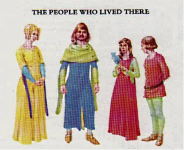LOCAL CONDITIONS IN 1408
The population of Bramham at the time is not known but an idea of its size can be gained from the fact that 29 years earlier the 1379 poll tax return, designed to include the names of all persons over the age of 16 years (clergy and ‘notorious mendicants being exempt), showed that Bramham had 82 taxpayers. In comparison Wetherby had 98. Farming was the main occupation of the region so it is likely that the majority of Bramham’s male population were agricultural labourers. The effect of the Black Death in the middle of the 1300s had by this time immeasurably improved the lot of these workers because labour had become scarce and land abundant enabling landless people to take over abandoned land
Excavations in other areas indicate that by the start of the 15th century most villages consisted mainly of substantial houses, the labourers’ houses being structures of standard size but distinguished from the houses of the better-off by the quality and quantity of the materials used, or the standard of carpentry. Houses were generally built about a cruck frame, shaped like an ‘A’, of jointed timbers. The spaces between timbers were filled with wattle and daub (panels of woven branches and clay) then painted with a mixture of lime and water for protection. Windows had no glass; wooden shutters gave protection from wind and rain and all houses had a hall open to the roof. In a peasant house, everybody in the family, which probably included three generations, shared the hall for eating, sleeping and relaxing. With greater prosperity, a room for sleeping may have been introduced at first floor level at one end of the hall. Their possessions included pewter tableware, glazed pots, dice, cards, footballs and musical instruments. In addition to bread and cheese they ate pork, lamb and beef, fruit and vegetables and even fish. Village life was healthier than life in a town but nevertheless infant mortality was high, childbirth was dangerous and agricultural labourers were old at 40. Animals drank at the pond and grazed on common land there being in those days none of the fields separated by hedges that came with the enclosure act over four centuries later.
It is probable that none of Bramham’s villagers were directly involved in the combat on the day because, unlike the situation in Wetherby, Tadcaster and the villages on the north side of the River Wharfe, it is not thought that any Bramham residents were tenants of the Percy family.
|

WHERE A 14th-CENTURY FAMILY ATE AND SLEPT
The main part of a medieval House was the hall, with its fire burning in the centre, and smoke drifting into the rafters. Meals were cooked either over the fire or in a detached kitchen. In a simple yeoman’s (small farmer’s) house, the family probably slept in a first-floor room. |
|
|

THE SELF-SUFFICIENT YEOMAN FAMILY
Yeoman farmers were the tenants or freeholders who worked small farms of about 30 acres. The yeoman and his family were self-sufficient, cultivating their land themselves, and keeping sheep, cattle, hens, pigs and bees. In time of war the yeoman could be called on to fight for his lord and he was compelled by law to own a bow and arrows.
|
